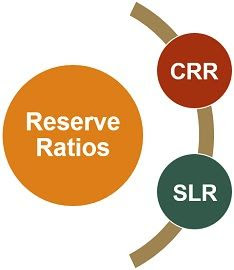Cash Reserve Ratio, or popularly known as CRR is a compulsory reserve that must be maintained with the Reserve Bank of India. Every bank is required to maintain a specific percentage of their net demand and time liabilities as cash balance with the RBI. CRR is the percentage of total deposits, which a commercial bank has to keep as reserves in the form of cash with the RBI. The banks are not allowed to use that money, kept with RBI, for economic and commercial purposes. It is a tool used by the apex bank to regulate the liquidity in the economy and control the flow of money in the country.
Therefore, if the RBI wants to increase the money supply in the economy, it will reduce the rate of CRR while, if RBI seeks to decrease the money supply in the market then it will increase the rate of CRR.
Statutory Liquidity Ratio (SLR) is a percentage of Net Time and Demand Liabilities kept by the bank in the form of liquid assets. It is used to maintain the stability of banks by limiting the credit facility offered to its customers. The banks hold more than the required SLR and the purpose of maintaining the SLR is to hold a certain amount of money in the form of liquid assets, so as to fulfill the demand of the depositors when arises.
Here, Time Liabilities mean the amount of money which is made payable to the customer after a period of time while the demand liabilities means the amount of money which is made payable to the customer at the time when it is demanded.

Comments
Post a Comment